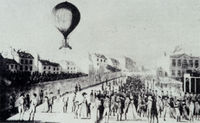Annotation:Air Balloon (1) (The): Difference between revisions
No edit summary |
No edit summary |
||
| Line 2: | Line 2: | ||
---- | ---- | ||
<p><font face="garamond, serif" size="4"> | <p><font face="garamond, serif" size="4"> | ||
'''AIR BALLOON, THE.''' English, Country Dance Tune (cut time). A Major. Standard tuning (fiddle). AABB. The melody probably refers to the hot-air balloon ascent of Italian balloonist Vincenzo Lunardi (Vincent Lunardi) in September 1784, watched by a crowd of some 150,000, including the Prince of Wales (later George IV). Lunardi's was not the first ascent, for there were balloon flights in France in 1783, and, a month previously, in Edinburgh by James Tytler. Lunardi's was the first in English skies, however, and he | '''AIR BALLOON, THE.''' English, Country Dance Tune (cut time). A Major. Standard tuning (fiddle). AABB. The melody probably refers to the hot-air balloon ascent of Italian balloonist Vincenzo Lunardi (Vincent Lunardi) in September 1784, watched by a crowd of some 150,000, including the Prince of Wales (later George IV). Lunardi's was not the first ascent, for there were balloon flights in France in 1783, and, a month previously, in Edinburgh by James Tytler. Lunardi's was the first in English skies, however, and he made a sensation when he took off accompanied by a cat, a dog and a pigeon. | ||
[[File:lunardi.jpg|200px|thumb|left|Lunardi takes off from the grounds of the Honourable Artillery Company in East London on the 15 September 1784.]] | [[File:lunardi.jpg|200px|thumb|left|Lunardi takes off from the grounds of the Honourable Artillery Company in East London on the 15 September 1784.]] | ||
Lunardi was feted by the city after his feat, and was made an honorary member of the Honourable Artillery Company. King George III granted him a special audience and he was presented with a watch by the Prince of Wales. His balloon became an attraction when exhibited at the Pantheon, a London theater. Unfortunately, Lunardi was unable to translate his fame into lasting success, and he died twelve years later in a in poverty in a monastery in Portugal. | Lunardi was feted by the city after his feat, and was made an honorary member of the Honourable Artillery Company. King George III granted him a special audience and he was presented with a watch by the Prince of Wales. His balloon became an attraction when exhibited at the Pantheon, a London theater. Unfortunately, Lunardi was unable to translate his fame into lasting success, and he died twelve years later in a in poverty in a monastery in Portugal. | ||
Revision as of 03:10, 20 August 2012
Back to Air Balloon (1) (The)
AIR BALLOON, THE. English, Country Dance Tune (cut time). A Major. Standard tuning (fiddle). AABB. The melody probably refers to the hot-air balloon ascent of Italian balloonist Vincenzo Lunardi (Vincent Lunardi) in September 1784, watched by a crowd of some 150,000, including the Prince of Wales (later George IV). Lunardi's was not the first ascent, for there were balloon flights in France in 1783, and, a month previously, in Edinburgh by James Tytler. Lunardi's was the first in English skies, however, and he made a sensation when he took off accompanied by a cat, a dog and a pigeon.

Lunardi was feted by the city after his feat, and was made an honorary member of the Honourable Artillery Company. King George III granted him a special audience and he was presented with a watch by the Prince of Wales. His balloon became an attraction when exhibited at the Pantheon, a London theater. Unfortunately, Lunardi was unable to translate his fame into lasting success, and he died twelve years later in a in poverty in a monastery in Portugal.
Source for notated version:
Printed sources: Samuel, Ann & Peter Thompson (Compleat Collection of 200 Favourite Country Dances, vol. 5), 1788; p. 37.
Recorded sources:
Back to Air Balloon (1) (The)
